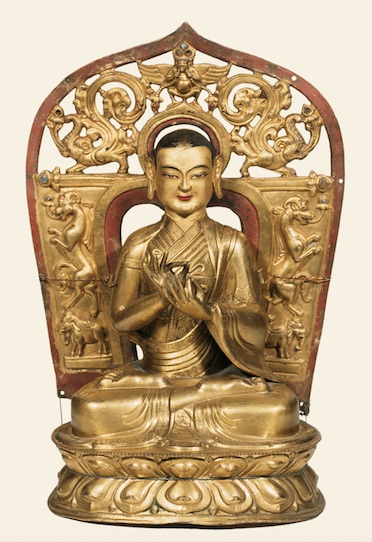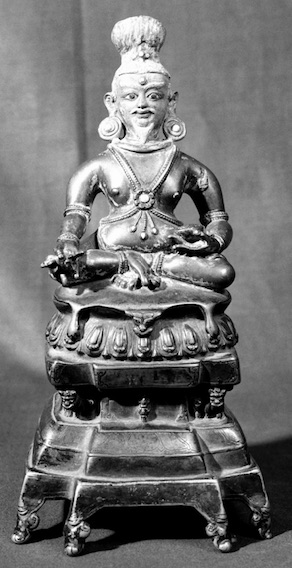Undated (15th century?), Tibet, (painted clay or wood?), Khenchen Jangchug Pelzango, Sakya Sribhadra, Jamyang Rinchen Gyaltsen, with recently replaced hands, photo by Dudul Dorjay, 2011 on virginia.edu, in the shrine dedicated to the masters of the Second Diffusion of Buddhism in Tibet, at the Pelkhor Chode monastic complex in Gyantse (Tibet).
From left to right, (Zulpu) Khenchen Jangchub Pelzangpo, a 14th century Tibetan master, Sakya Shribhadra, a 12th century Kashmiri scholar (see both on Treasury of Lives ) whose left hand originally displayed the gesture of debate (vitarka mudra), Jamyang Rinchen Gyaltsen, a 13th century Sakya master (see on wikipedia).
Undated (15th century?), Tibet, Choki Rinchen, Gyalse Thokme, Gangchen Khepe Wangpo Kungapel, (painted clay or wood?), photo by Dudul Dorjay, 2011 on virginia.edu, Sempa Shrine in the Gyantse Kumbum Stupa, at the Pelkhor Chode monastic complex in Gyantse (Tibet).
Circa 16th-17th century, Tibet, Dpal ldan tshul khrims (Palden Tsultrim), brass, 16,8 cm, object nº AK-MAK-1510 at the Rijksmuseum in Amsterdam (The Netherlands).
18th century, Tibet, Dpal ldan tshul khrims (Palden Sultrim), bronze, 19 cm, object nº AK-MAK-307 at the Rijksmuseum in Amsterdam (The Netherlands).
We saw a group of six Sakya Lamdre lineage masters including this lama on Bonhams . These two sculptures depict him with his right hand in the gesture of debate and the left hand in meditation, with a vase of longevity in the second case (possibly missing from the first one).
16th century, Tibet, probably Rin chen phun tshogs, gilt copper with cold gold and pigment, 27,5 cm, photo: courtesy of Ulrich von Schroeder, Buddhist Sculptures in Tibet Volume Two, Visual Dharma Publications, Hong Kong, p. 1075 pl. 277C, at the Gser khang lha khang, Bri gung mthil (Drigung Thil) monastery (Tibet).
Rinchen Phuntsog was an important Drikung/Drigung teacher who lived during the 16th century (see drikung.org). He was a layman, hence the long-sleeve outer garment tied with a belt (note the elegant knot).
18th century, Tibet, sMin gling gter chen ‘Gyur med rdo rje (Minling Terchen Gyurme Dorje), gilt copper, 10 cm, photo as before, p. 1082 pl. 281A, at the sMin grol gling (Mindroling) monastery (Tibet).
The author explains that according to an inscription at the back of the base, the founder of the Mindroling monastery is shown here at the age of 67. He holds a long-life vase in his left hand.













































